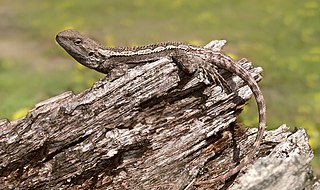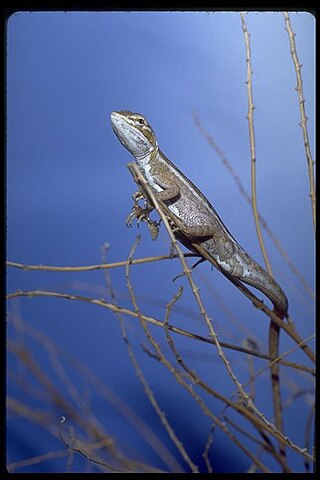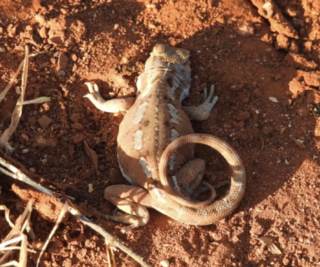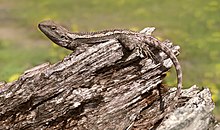
Diporiphora is a genus of lizards in the family Agamidae. Most species in the genus are endemic to Australia, but two are also found in New Guinea.

Tympanocryptis is a genus of Australian lizards in the family Agamidae, commonly known as earless dragons.

Cercosaura is a genus of lizards in the family Gymnophthalmidae. The genus is endemic to South America.

The eastern bearded dragon, also known as common bearded dragon or simply bearded lizard, is an agamid lizard found in wooded parts of Australia. It is one of a group of species known commonly as bearded dragons. Other common names for this species include Jew lizard and frilly lizard, the latter being a confusion between this and another dragon, the frill-necked lizard. This species was originally described in 1829 by Georges Cuvier, who named it Amphibolurus barbatus.

Oxybelis is a genus of colubrid snakes, endemic to the Americas, which are commonly known as vine snakes. Though similar in appearance to the Asian species of vine snakes of the genus Ahaetulla, they are not closely related, and are an example of convergent evolution.

Boyd's forest dragon is a species of arboreal lizard in the family Agamidae. The species is native to rainforests and their margins in the Wet Tropics region of northern Queensland, Australia. It is the larger of the two species of Lophosaurus found in Australia. Another species, the southern angle-headed dragon, L. spinipes, is found in southern Queensland and northern New South Wales.

Hoplocephalus is a genus of venomous snakes in the family Elapidae. The genus is endemic to Australia. Three species are recognized.

The jacky dragon is a type of lizard native to south-eastern Australia. Other common names include blood-sucker, stonewalker, and tree dragon. It was one of the first Australian reptiles to be named by Europeans, originally described by English zoologist George Shaw in Surgeon-General John White's Journal of a Voyage to New South Wales, published in London in 1790. The lizard is well-known for its bright yellow mouth and well-developed vertebral crest, as well as the temperature-dependent sex determination of its offspring.

The Amphibolurinae are a subfamily of lizards in the family Agamidae. Members of this subfamily are found in Australia and New Guinea, although one species, the Chinese water dragon, is found in Southeast Asia.

Enyalioides laticeps, the Amazon broad-headed wood lizard, is a dwarf iguanian lizard abundantly found in Amazonian rainforests. They are semi-arboreal and mostly live in forests. Other names for it include broad-headed wood lizards, Big-headed stick lizards, Guichenot's Dwarf Iguana, Amazon Forest Dragon, or Amazon Dwarf-Iguana. It is a small, ornamented lizard that grows up to 157 mm (0.5 ft) long and have very high vertebral crests along their backs. They change colors based on environmental factors. Amazon broad-headed wood lizards rely on rapid running to move around; however, they spend the vast majority of their time motionless, blending into the rainforest background, and ambushing prey. When attacked by predators, E. laticeps may stay motionless like a wood stick to avoid predation. When found by predators, it may suddenly spring into motion, quickly reatreting to burrows in the ground.

The central netted dragon or central netted ground dragon is a species of agamid lizard occurring in a wide range of arid to semiarid regions of Australia. It is widespread across the continent, commonly found in open, sandy, desert habitats. It is a popular pet and can often be found in zoos.

Ctenophorus pictus, commonly known as the painted ground-dragon or painted dragon, is a species of lizard from the family Agamidae. It is endemic to the drier areas of southern and central Australia.

Aspidura is a genus of snakes in the subfamily Natricinae of the Family Colubridae. The genus is endemic to island of Sri Lanka. Member species are commonly known as rough-sided snakes, except for A. ceylonensis, which is commonly known as the black-spined snake and was formerly in the genus Haplocercus. The genus Aspidura comprises nine species, with the latest having been discovered in 2019.

Diporiphora winneckei, also known commonly as the canegrass dragon, canegrass two-line dragon, blue-lined dragon, and Winnecke's two-pored dragon, is a species of small, terrestrial, diurnal lizard in the family Agamidae. The species is endemic to Australia. It is found throughout arid zones of Australia and is also a common house pet.

Smaug is a genus of lizards in the family Cordylidae. The genus Smaug is a group of species of spiny southern African lizards, separated from the genus Cordylus in 2011 on the basis of a comprehensive molecular phylogeny of the Cordylidae. The type species is the giant girdled lizard, S. giganteus.
The gibber earless dragon also known as the smooth-snouted earless dragon, is a species of agamid lizard endemic to Australia. It is one of a documented species of the genus Tympanocryptis, a group of small terrestrial lizards that feed off invertebrates and are characterised by the absence of an external ear structure.
Ctenophorus mckenziei, more commonly known as the dwarf-bicycle dragon, is a species of endemic Australian lizard within the family Agamidae and genus Ctenophorus. Originally identified as the agamid Amphibolurus mckenziei, the lizard had been identified within the regions of Western Australia and South Australia in which it occupied the shrubbery and woodland areas as its habitat. It was subsequently transferred to the genus Ctenophorus along with other Agamid species in which it shared similar morphology and characteristics. The name mckenziei is in reference to Norman Leslie Mckenzie, who was a zoologist and discovered the existence of the lizard. Listed on the IUCN red list page, threats to its population numbers are evaluated as least concern; however, their numbers are threatened by habitat loss, climate change, and feral predators.

Ctenophorus parviceps, commonly known as the Gnaraloo heath dragon or northwestern heath dragon is a species of agamid lizard occurring in pale coastal sands and shell grit with open heaths and beach spinifex, between the North West Cape and Carnarvon, Western Australia and on Bernier Island. The Gnaraloo heath dragon is a lizard that can be found along the coast of Western Australia between Exmouth Gulf and Shark Bay, and is also known as the northwestern heath dragon. It is native to Australia and usually inhabits sandy coastal dunes. The species' longevity is 3–50 years and its population density is extremely low. The Gnaraloo heath dragon is a member of the Agamidae family, which contains 15 genera. The lizard is under the Ctenophorus genus which has up to 33 species. This genus shows the most morphological and ecological diversity out of the three large agamid genera. 83% of the lizards in this genus lack a crest, while 17% possess crests. They are smaller than most agamids but do have relatively large heads. The Gnaraloo heath dragon can be differentiated from related species by a series of spines on the tail's base, a pale-grey brown broad vertebral band along its back, and hour-glass bars extending upwards to meet the pale vertebral band. It is usually 45mm in terms of length, measuring from snout to vent.

Tropicagama is a genus of large-bodied lizards in the family Agamidae. The genus is monotypic, with only one species listed: Tropicagama temporalis, commonly known as the swamplands lashtail or northern water dragon. This semi-arboreal species inhabits the tropical savannah woodlands of northern Australia, as well as parts of New Guinea and southeastern Indonesia.

Diporiphora nobbi, also known commonly as the nobbi lashtail or the nobbi, is a species of lizard in the family Agamidae. The species is endemic to Australia.


















